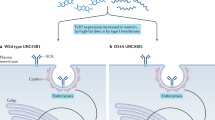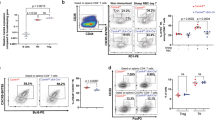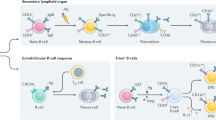Abstract
B cells are important in the development of autoimmune disorders by mechanisms involving disregulated polyclonal B-cell activation, production of pathogenic antibodies, and co-stimulation of autoreactive T cells. zTNF4 (BLyS, BAFF, TALL-1, THANK)1,2,3,4,5 is a member of the tumour necrosis factor (TNF) ligand family that is a potent co-activator of B cells in vitro and in vivo1,2,5. Here we identify two receptors for zTNF4 and demonstrate a relationship between zTNF4 and autoimmune disease. Transgenic animals overexpressing zTNF4 in lymphoid cells develop symptoms characteristic of systemic lupus erythaematosus (SLE) and expand a rare population of splenic B-1a lymphocytes. In addition, circulating zTNF4 is more abundant in NZBWF1 and MRL-lpr/lpr mice during the onset and progression of SLE. We have identified two TNF receptor family members, TACI6 and BCMA7,8, that bind zTNF4. Treatment of NZBWF1 mice with soluble TACI–Ig fusion protein inhibits the development of proteinuria and prolongs survival of the animals. These findings demonstrate the involvement of zTNF4 and its receptors in the development of SLE and identify TACI–Ig as a promising treatment of autoimmune disease in humans.
This is a preview of subscription content, access via your institution
Access options
Subscribe to this journal
Receive 51 print issues and online access
$199.00 per year
only $3.90 per issue
Buy this article
- Purchase on SpringerLink
- Instant access to full article PDF
Prices may be subject to local taxes which are calculated during checkout




Similar content being viewed by others
References
Moore,P. A. et al. BLyS: Member of the tumor necrosis factor family and B lymphocyte stimulator. Science 285, 260– 263 (1999).
Scheider,P. et al. BAFF, a novel ligand of the tumor necrosis factor family, stimulates B cell growth. J. Exp. Med. 189, 1747–1756 (1999).
Shu,H., Hu,W. & Johnson,H. TALL-1 is a novel member of the TNF family that is down-regulated by mitogens. J. Leukoc. Biol. 65, 680– 683 (1999).
Mukhopadhyay,A., Ni,J., Zhai,Y., Yu,G. & Aggarwal,B. Identification and characterization of a novel cytokine, THANK, a TNF homologue that activates apoptosis, nuclear factor-κB, and c-Jun NH2-terminal kinase. J. Biol. Chem. 274, 15978– 15981 (1999).
Mackay,F. et al. Mice transgenic for BAFF develop lymphocytic disorders along with autoimmune manifestations. J. Exp. Med. 190, 1697–1710 (1999).
von Bülow,G.-U. & Bram,R. J. NF-AT activation induced by a CAML-interacting member of the tumor necrosis factor receptor superfamily. Science 278, 138– 141 (1997).
Laâbi,Y. et al. A new gene, BCM, on chromosome 16 is fused to the interleukin 2 gene by a t(4;16)(q26;p130) translocation in a malignant T cell lymphoma. EMBO J. 11, 3897–3904 (1992).
Maldry,C. et al. The characterization of murine BCMA gene defines it as a new member of the tumor necrosis factor receptor superfamily. Int. Immunol. 10, 1693–1702 ( 1998).
Smith,C. A., Farrah,T. & Goodwin,R. G. The TNF-receptor superfamily of cellular and viral proteins: activation, costimulation, and death. Cell 76, 959–962.
Bodrug,S. E. et al. Cyclin D1 transgene impedes lymphocyte maturation and collaborates in lymphomagenesis with the myc gene. EMBO J. 13, 2124–2130 (1994).
Hu,J. et al. An evaluation of the potential to use tumor-associated antigens as targets for antitumor T cell therapy using transgenic mice expressing a retroviral tumor antigen in normal lymphoid tissues. J. Exp. Med. 177, 1681–1690 ( 1993).
Hardy,R. R., Carmack,C. E., Li,Y. S. & Hayakawa,K. Distinctive developmental origins and specificities of murine CD5+ B cells. Immunol. Rev. 137, 91–95 (1994).
Foster,M. H. Relevance of systemic lupus erythematosus nephritis animal models to human disease. Semin. Nephrol. 19, 12– 24 (1999).
Cohen,P. L. & Eisenberg,R. A. Lpr and gld: single gene models of systemic autoimmunity and lymphproliferative diesease. Annu. Rev. Immunol. 9, 243–269 (1991).
Gras,M.-P. et al. BCMAp: an integral membrane protein in the Golgi apparatus of human mature B lymphocytes. Int. Immunol 7, 1093–1106 (1995).
Kotzin,B. L. Systemic lupus erythematosus. Cell 85, 303 –306 (1996).
Chan,O. et al. A novel mouse with B cells but lacking serum antibody reveals an antibody-independent role for B cells in murine lupus. J. Exp. Med. 189, 1639–1647 ( 1999).
Raymond,C. K. et al. Development of the methylotrophic yeast Pichia methanolica for the expression of the 65 kilodalton isoform of human glutamate decarboxylase. Yeast 14, 11–23 (1998).
Seeburg,P. H. The human growth hormone gene family: nucleotide sequences show recent divergence and predict a new polypeptide hormone DNA. DNA 1, 239–249 (1982).
Wofsy,D. & Seaman,W. E. Successful treatment of autoimmunity in NZB/NZW F1 mice with monoclonal antibody to L3T4. J. Exp. Med. 161, 378–391 ( 1985).
Davis,S. et al. Isolation of angiopoietin-1, a ligand for the TIE2 receptor, by secretion-trap expression cloning. Cell 87, 1161–1169 (1996).
Acknowledgements
We thank D. Wofsy, R. Bram and A. Nelson for helpful discussions; K. Waggie, L. Wilcox, B. Hansen, J. Lenox, C. Bosnick, S. Bayna and M. Caputo for generation and analysis of transgenic animals; A. Thorstrud, P. Shea, T. Bukowski, N. Hamacher, M. Stamm, K. De Jongh, K. Swiderek and J. Forstrom for protein purification and analysis; J. Volpone and S. McMillen for generation of antibody reagents and assay development; and C. Brandt for binding studies using zTNF4.
Author information
Authors and Affiliations
Corresponding author
Rights and permissions
About this article
Cite this article
Gross, J., Johnston, J., Mudri, S. et al. TACI and BCMA are receptors for a TNF homologue implicated in B-cell autoimmune disease. Nature 404, 995–999 (2000). https://doi.org/10.1038/35010115
Received:
Accepted:
Issue Date:
DOI: https://doi.org/10.1038/35010115



